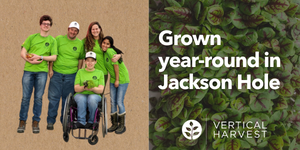 May is the month for planning, planting and even beginning to harvest from your vegetable and herb garden. Living in the Jackson area, we are limited by our short growing season, but with the right preparation and care, anyone anwhere can grow a multitude of crops.
May is the month for planning, planting and even beginning to harvest from your vegetable and herb garden. Living in the Jackson area, we are limited by our short growing season, but with the right preparation and care, anyone anwhere can grow a multitude of crops.
If you find yourself taking care of your garden out of crop season, and in season you have little time to maintain your garden because of taking care of your vegetables and herbs, you might want to look into garden care services like Trugreen in Georgia (they operate in many different states in the US too!). This time, though, we’re determined to make some changes to our garden to make it more appealing. There are so many websites on the internet that choosing one can be difficult. One of our friends recommended that I look at websites like Garden stone (you could browse here for more information) to get ideas for what materials we want in our garden.
First and foremost, now is the time to prep your soil for the upcoming season. With the ground unfrozen, you can begin tilling and cultivating your soil. If you added to compost or any other organic amendments to your beds in the fall, you’ll need to loosen up that soil and break up any clumps. Now is also a good time to add a little more compost, fertilizer, or potting soil as you’re already mixing things around. It is better to use homemade compost than chemical fertilizer. Of course, you might have to face flies and Maggots in compost, but they help break down the food waste faster. Choose whichever is easier for you. Your soil should be loosely packed down to about a foot or two deep and spread out to a level surface. Once the soil is ready for planting, you can add any sort of trellises, supports, or borders to your beds, depending of course on what you plan on planting. With the weather being unpredictable any time of year in Jackson, I finish my garden prep by readying my row covers. Young plants, either newly transplanted or recently sprouted from seed are especially vulnerable to an overnight frost and you’ll benefit from being able to protect them at a moment’s notice. To accomplish this, I simply have some PVC pipe arcing across my raised beds that I can pull a sheet or frost cloth over. The PVC pipe is held in place by tall nails or stakes and you can secure the cloth or sheet to the ground using stones or other stakes.
Now is the fun part-mapping out and planning for this season’s garden. If you took notes on your garden last year, pull those out and reference them as you plan for this season. Make particular note of where each plant was located in your beds and what did not perform well. When deciding what to plant this season, I make a list of those vegetables that did particularly well last year and those that I’d like to try either again or for the first time.
Whether you are planting a crop you’ve done before or are trying something new you should always pay close attention to the following:
- Space needed
- Water needed
- Light needed
- Time to mature (I avoid plants that require over 90 days to mature)
- Tolerance to both cold and heat
Knowing these details about each item in your garden will tell you where to plant, when to plant and whether or not you should plant it at all. Apparently people have been getting into growing hemp herbs outside (for which you can find ganja seeds here) as a trend but have not been researching the plant’s requirements and planting it incorrectly, stunting the growth. Some plants like that aforementioned may require you to not directly plant them outside as a seed but instead, transplant a germinated plant (either grown indoors from seed or as a purchased starter).
Most importantly, (growing conditions aside) don’t grow too much. I remember what I begrudgingly forced into my diet due to too much yield and what I wish I had more of-this is, after all, a foodie’s garden!
I also try to be mindful of some tried and true crop rotation practices:
- Follow beans with cauliflower, carrots, broccoli, cabbage or corn, but do not follow with onions or garlic.
- Follow beets with spinach.
- Follow carrots with lettuce or tomatoes but not with dill.
- Follow cucumbers with peas or radishes.
- Follow kale with beans or peas.
- Follow lettuce with carrots, cucumbers or radishes.
- Follow onions with radishes or lettuce.
Once my list is made, I begin to map out my beds with those above considerations in mind. Crops like lettuces, spinach, radishes, and arugula grow quickly and are fairly frost tolerant so you can plant them directly from seed when your beds are ready. I like to reserve one bed for these early crops and as soon as the heat of the summer arrives, I replace the bed with a more tender, heat and space loving plant that needs to be transplanted into the garden like squash or cucumbers. On the other hand, some crops, like broccoli and Brussels sprouts prefer the cooler weather and can’t handle the summer heat. If you haven’t already started these plants indoors from seed, you’ll want to only plant these vegetables in your garden as transplants, rather than from seed or they won’t have time to mature before the heat arrives. Likewise, plants like beets, carrots, parsnip, chard, kale, onions, leeks and garlic require a long time to mature but are cold-tolerant so you can actually put those seeds in the ground as soon as your beds are ready.
And finally, planting! Get those cold season seeds or starts in the ground and be weary of imminent weather in case you need to throw the cover over them at a moment’s notice. If you are growing your own, warm-season starts indoors, get those going. Start your tender herbs like basil, cilantro and parsley indoors in pots that you can move outdoors as soon as the weather dictates it.
Don’t forget to take notes, keep it simple, start small and remember what you’ll actually eat!













